The Rise of Decentralized Exchange Aggregation
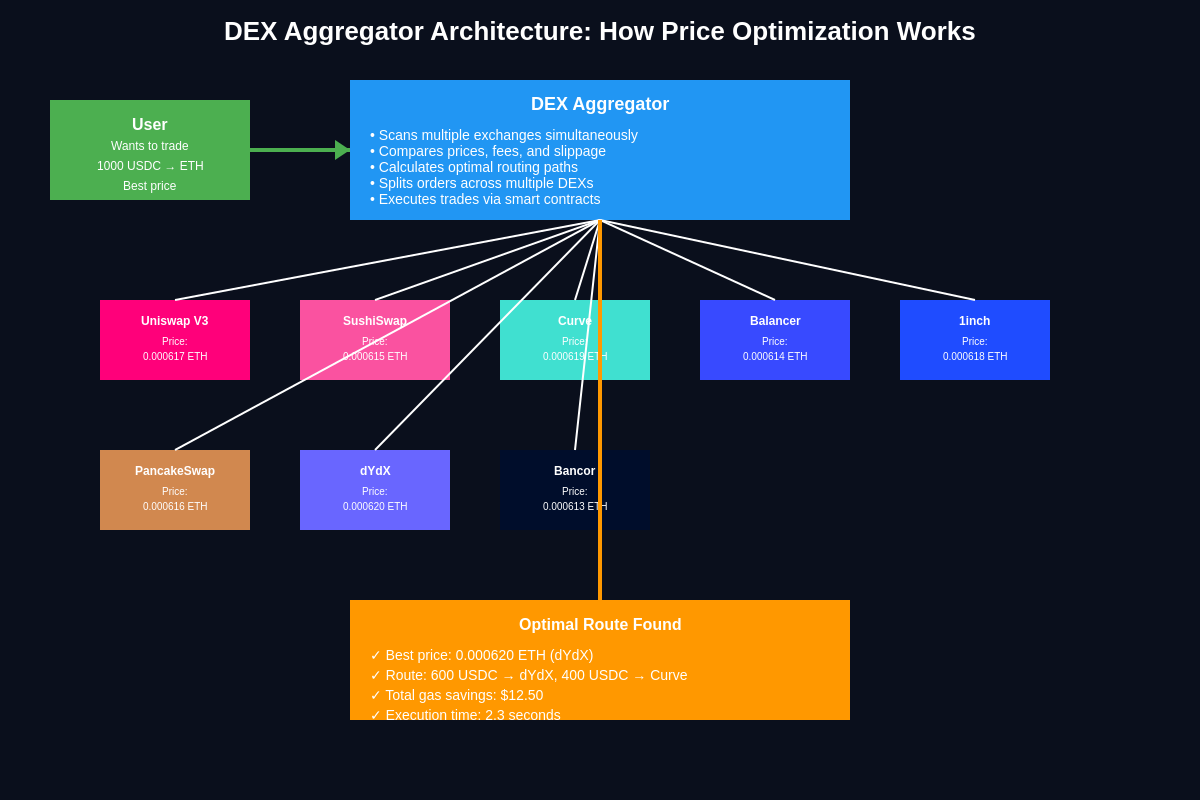
The decentralized finance ecosystem has witnessed explosive growth over the past few years, with hundreds of decentralized exchanges offering trading services across multiple blockchain networks. This proliferation of trading venues has created both opportunities and challenges for cryptocurrency traders seeking optimal execution prices. While the abundance of DEXs provides increased liquidity and trading options, it also fragments the market, making it increasingly difficult for individual traders to manually identify the best prices across all available platforms.
DEX aggregators have emerged as sophisticated technological solutions to this market fragmentation problem, serving as intelligent routing systems that automatically scan multiple decentralized exchanges to find the most favorable trading conditions for any given transaction. These platforms leverage advanced algorithms and real-time data feeds to analyze liquidity pools, trading fees, slippage rates, and execution speeds across numerous exchanges simultaneously, presenting users with optimized trading routes that maximize value while minimizing costs.
The fundamental value proposition of DEX aggregators lies in their ability to abstract away the complexity of multi-exchange comparison and routing, transforming what would otherwise require extensive manual research and calculation into a seamless, automated process. Professional traders utilizing comprehensive DeFi market analysis tools can leverage these aggregators to enhance their trading strategies while maintaining the decentralized, non-custodial nature that defines the DeFi ecosystem.
Understanding DEX Aggregator Architecture
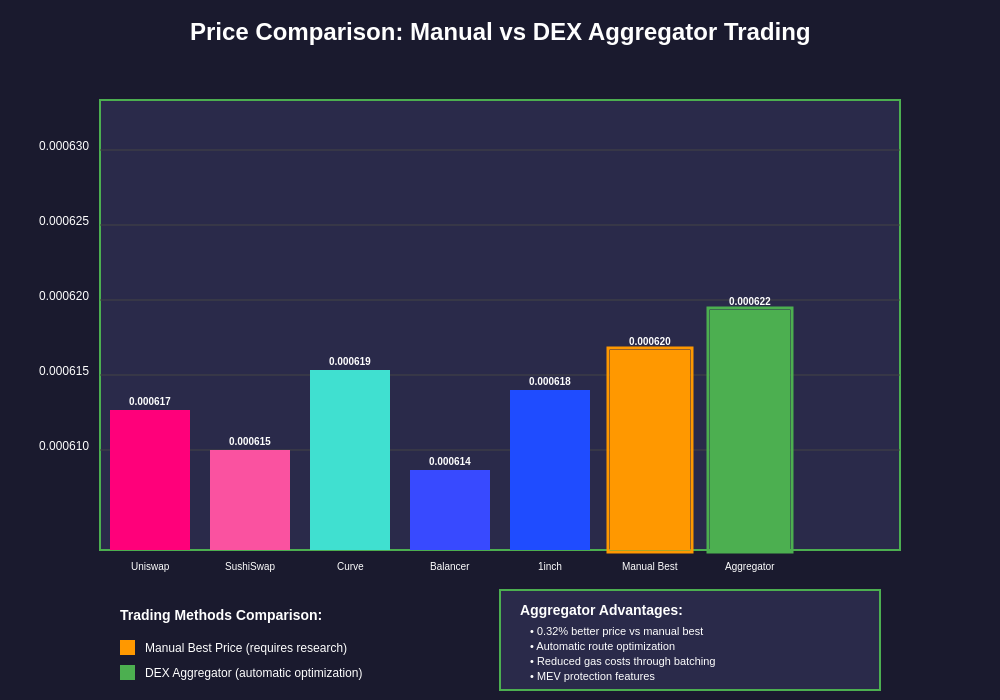
The technical architecture underlying DEX aggregators represents a sophisticated blend of smart contract integration, algorithmic optimization, and real-time data processing. At its core, a DEX aggregator functions as an intermediary layer that interfaces with multiple underlying decentralized exchanges through standardized protocols and APIs, collecting real-time pricing data, liquidity information, and trading parameters from each connected platform.
The aggregation process begins with the collection of comprehensive market data from integrated exchanges, including order book depth, available liquidity pools, current prices, trading fees, and gas costs associated with transaction execution on each platform. This information is continuously updated to reflect the dynamic nature of DeFi markets, where prices and liquidity conditions can change rapidly based on trading activity, arbitrage opportunities, and external market factors.
Advanced routing algorithms form the computational heart of DEX aggregators, analyzing the collected market data to determine optimal trade execution paths. These algorithms consider multiple variables simultaneously, including the size of the desired trade, available liquidity at each price level, potential slippage impact, transaction costs, and execution speed requirements. The optimization process often involves complex mathematical calculations that evaluate thousands of possible routing combinations to identify the path that delivers maximum value to the user.
Smart contract integration enables DEX aggregators to execute trades seamlessly across multiple platforms without requiring users to interact with each exchange individually. The aggregator’s smart contracts are designed to split large orders across multiple DEXs when beneficial, combine liquidity from different sources, and handle the technical complexities of multi-step transactions while maintaining the security and transparency inherent in blockchain-based systems.
Major DEX Aggregator Platforms and Their Unique Features
The DEX aggregator landscape features several prominent platforms, each offering distinct approaches to trade optimization and user experience. 1inch Network stands as one of the most recognizable names in the space, pioneering many of the algorithmic innovations that have become standard across the industry. The platform’s Pathfinder algorithm analyzes routes across dozens of DEXs and AMMs, including Uniswap, SushiSwap, Balancer, and Curve, to find optimal trading paths that often involve multiple hops and sophisticated routing strategies.
1inch’s Chi GasToken integration represents an innovative approach to gas cost optimization, allowing users to mint and burn gas tokens during periods of low network congestion to reduce transaction costs during high-demand periods. The platform’s limit order functionality further extends its capabilities beyond simple market orders, enabling users to set specific price targets and automated execution conditions that rival those found on centralized exchanges.
Matcha, developed by the 0x Protocol team, emphasizes user experience and institutional-grade features while maintaining the sophisticated routing capabilities expected from a leading aggregator. The platform’s integration with 0x’s professional market maker network provides access to additional liquidity sources beyond traditional AMMs, often resulting in superior pricing for larger trades. Matcha’s focus on regulatory compliance and institutional features makes it particularly attractive to professional trading organizations and larger investors seeking DEX aggregator services.
ParaSwap has distinguished itself through its comprehensive multi-chain support and advanced MEV protection features. The platform’s algorithms actively work to prevent front-running and sandwich attacks that can erode trading profits, implementing various protective measures including private mempool submission and MEV-resistant routing strategies. ParaSwap’s MultiPath feature can split single trades across numerous DEXs simultaneously, often achieving better pricing than would be possible through any individual exchange.
CowSwap introduces a unique approach to DEX aggregation through its batch auction mechanism and MEV protection focus. Rather than immediately executing trades through traditional AMM routing, CowSwap collects orders and processes them in batches, allowing for coincidence of wants matching that can eliminate slippage entirely for certain trades. The platform’s integration with Gnosis Safe and focus on MEV extraction prevention makes it particularly appealing to sophisticated traders and DAOs managing substantial treasuries.
The Economics of Price Discovery and Arbitrage
DEX aggregators play a crucial role in the broader DeFi ecosystem’s price discovery mechanism, serving as catalysts for arbitrage activities that help maintain price consistency across different trading venues. When price discrepancies emerge between exchanges due to varying levels of trading activity or liquidity imbalances, aggregators quickly identify these inefficiencies and route trades to capture the most favorable prices available.
The arbitrage opportunities identified by DEX aggregators often stem from temporary imbalances in liquidity provision across different AMMs. For example, a large trade on Uniswap might move prices significantly due to the constant product formula, while the same token pair on Curve might maintain more stable pricing due to its specialized stable coin trading algorithm. Aggregators can capitalize on these differences by routing trades to the exchange offering better pricing conditions.
However, the pursuit of optimal pricing through aggregation comes with inherent trade-offs that sophisticated traders must understand. While aggregators excel at finding the best instantaneous prices, the additional smart contract interactions required for complex routing can increase gas costs and execution time. Professional traders monitoring DEX trading volumes and arbitrage opportunities often need to weigh the potential savings from better pricing against the increased transaction costs associated with multi-hop routing.
The temporal aspect of DEX aggregation presents additional complexity, as the optimal route identified at the time of order submission may no longer be available by the time the transaction is included in a block. This execution risk is particularly pronounced during periods of high network congestion or market volatility, when prices can move significantly between transaction submission and confirmation.
Advanced Routing Algorithms and Optimization Strategies
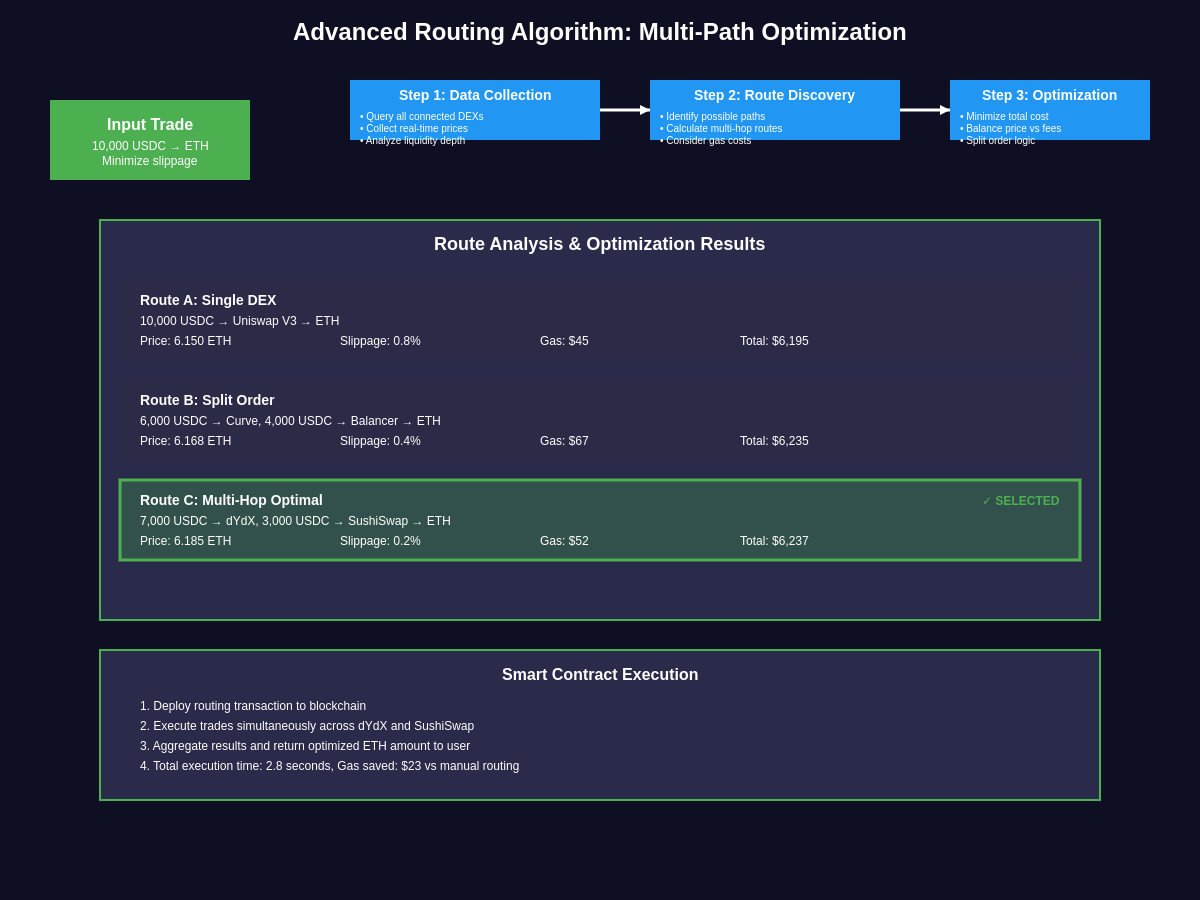
The sophistication of modern DEX aggregator routing algorithms represents years of refinement and optimization, incorporating insights from traditional algorithmic trading, game theory, and blockchain-specific considerations. These algorithms must solve complex multi-dimensional optimization problems that account for numerous variables simultaneously while operating under the constraints of blockchain execution environments.
Dynamic programming techniques form the foundation of many routing algorithms, breaking down complex multi-hop routing problems into smaller, manageable subproblems that can be solved efficiently. The algorithms evaluate potential routes by constructing decision trees that explore different combinations of exchanges, liquidity pools, and routing paths, calculating the expected outcome for each possibility and selecting the path that maximizes user value.
Machine learning integration has become increasingly prevalent in advanced aggregator systems, with algorithms that learn from historical trading patterns, gas price fluctuations, and market microstructure dynamics to improve routing decisions over time. These systems can identify subtle patterns in market behavior that might not be immediately apparent through traditional analysis, such as optimal timing for multi-step arbitrage strategies or predictive models for gas price movements.
The consideration of maximum extractable value (MEV) has become a critical component of modern routing algorithms, as aggregators must balance the pursuit of optimal pricing with protection against front-running and sandwich attacks. Advanced algorithms incorporate MEV awareness into their routing decisions, sometimes choosing suboptimal routes from a pure pricing perspective to avoid exposing users to potential MEV extraction.
Real-time adaptation capabilities allow sophisticated aggregators to adjust their routing strategies based on current network conditions, including gas prices, block congestion levels, and observed MEV activity. These systems can dynamically switch between aggressive optimization strategies during periods of low network activity and more conservative approaches when conditions suggest higher risks of MEV extraction or failed transactions.
Gas Optimization and Transaction Cost Management
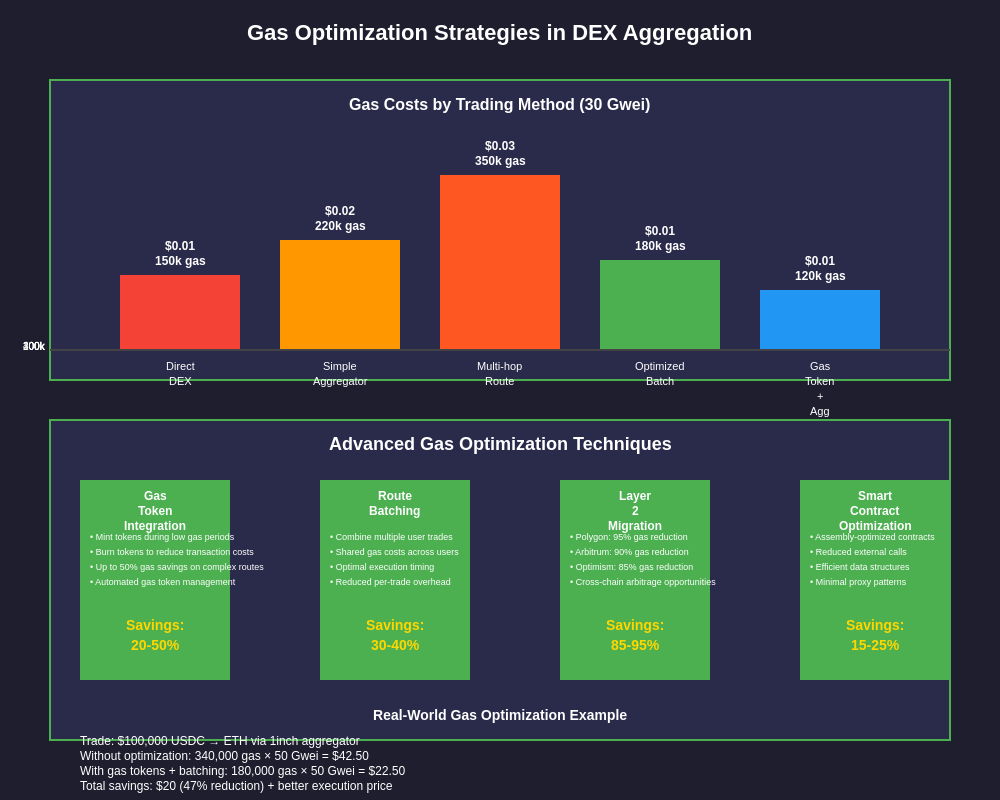
The relationship between gas costs and routing optimization represents one of the most complex aspects of DEX aggregator design, as the pursuit of better token prices must be balanced against the additional transaction costs incurred through complex routing strategies. Simple swaps through a single DEX typically require minimal gas consumption, while sophisticated multi-hop routes across multiple platforms can consume significantly more computational resources and incur higher transaction fees.
Advanced aggregators employ sophisticated gas estimation algorithms that predict the total transaction cost for different routing options, incorporating both the base gas requirements for smart contract execution and the current network gas price conditions. These systems often maintain databases of historical gas consumption patterns for different types of operations, enabling accurate cost predictions that factor into routing optimization decisions.
Gas token strategies represent an innovative approach to transaction cost management, allowing users and aggregators to effectively hedge against gas price volatility. During periods of low network congestion when gas prices are minimal, gas tokens can be minted and stored for later use when network demand increases. Some aggregators integrate gas token functionality directly into their routing algorithms, automatically utilizing stored gas tokens when economically beneficial.
The timing of trade execution plays a crucial role in gas cost optimization, as network congestion and gas prices exhibit predictable patterns throughout different time periods. Professional traders utilizing real-time gas price tracking and network analysis can optimize their aggregator usage by timing trades during periods of lower network congestion, significantly reducing overall transaction costs.
Layer 2 integration has emerged as a transformative development in gas cost management, with leading aggregators expanding their operations to include Polygon, Arbitrum, Optimism, and other scaling solutions. These integrations enable users to access DEX aggregation services with dramatically reduced transaction costs, though often with trade-offs in terms of available liquidity and cross-chain bridging requirements.
MEV Protection and Front-Running Prevention
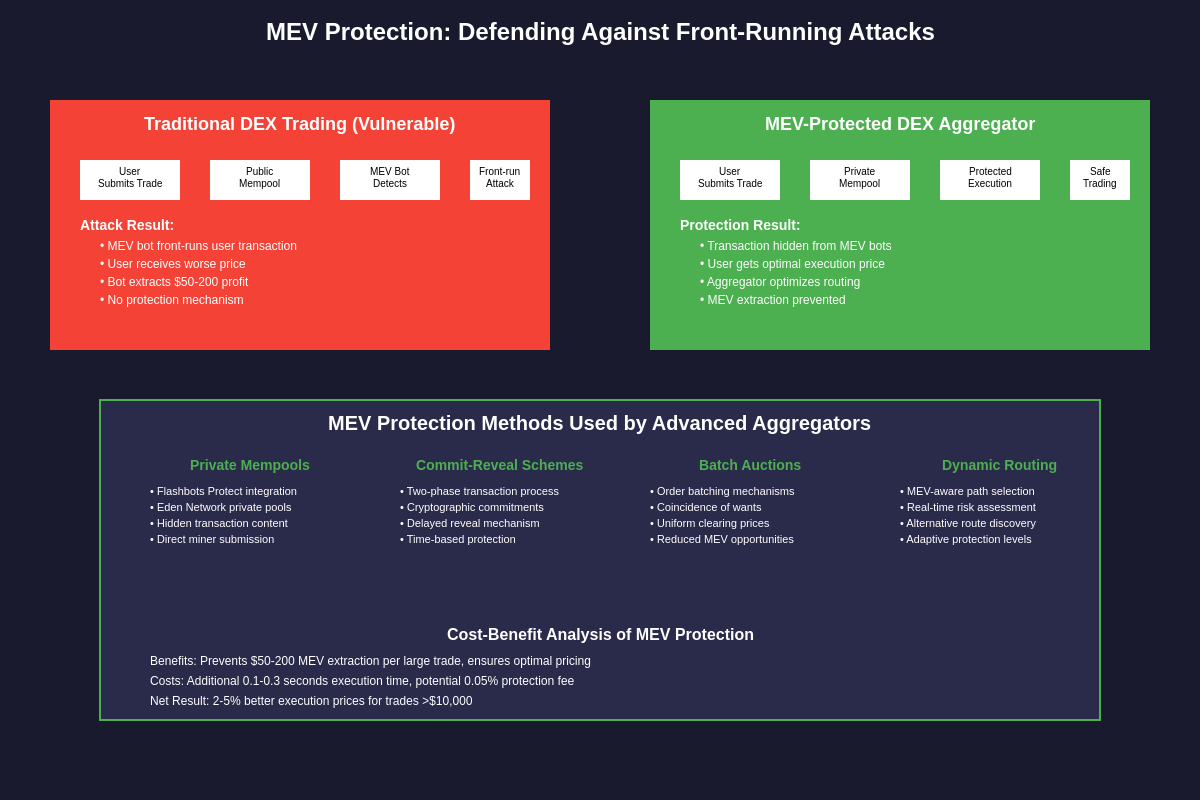
Maximum Extractable Value (MEV) represents one of the most significant challenges facing DEX users, as sophisticated bots continuously monitor pending transactions to identify profitable arbitrage opportunities that can be extracted at the expense of regular traders. DEX aggregators have responded to this threat by implementing various MEV protection mechanisms designed to shield users from front-running attacks, sandwich attacks, and other forms of MEV extraction.
Private mempool submission has become a standard feature among leading aggregators, routing transactions through private channels that prevent MEV bots from observing pending trades before they are included in blocks. Services like Flashbots Protect and Eden Network provide infrastructure for private transaction submission, though the effectiveness of these solutions varies depending on network conditions and the specific type of MEV attack being attempted.
Commit-reveal schemes represent another approach to MEV protection, requiring users to submit cryptographically hidden transaction details that are only revealed after a specified time period. This mechanism prevents MEV bots from front-running trades based on transaction content, though it introduces additional complexity and potential execution delays that may not be suitable for all trading scenarios.
Batch auction mechanisms, as implemented by platforms like CowSwap, offer a fundamentally different approach to MEV protection by aggregating multiple trades and executing them simultaneously. This batching process can eliminate or significantly reduce MEV opportunities by removing the temporal advantages that bots exploit in traditional sequential execution models.
The economic analysis of MEV protection involves complex trade-offs between security, execution speed, and cost efficiency. While MEV protection mechanisms can save users from value extraction, they often introduce additional latency or fees that may offset some of the benefits. Advanced aggregators provide users with options to customize their MEV protection preferences based on their specific trading requirements and risk tolerance.
Cross-Chain Aggregation and Multi-Network Trading
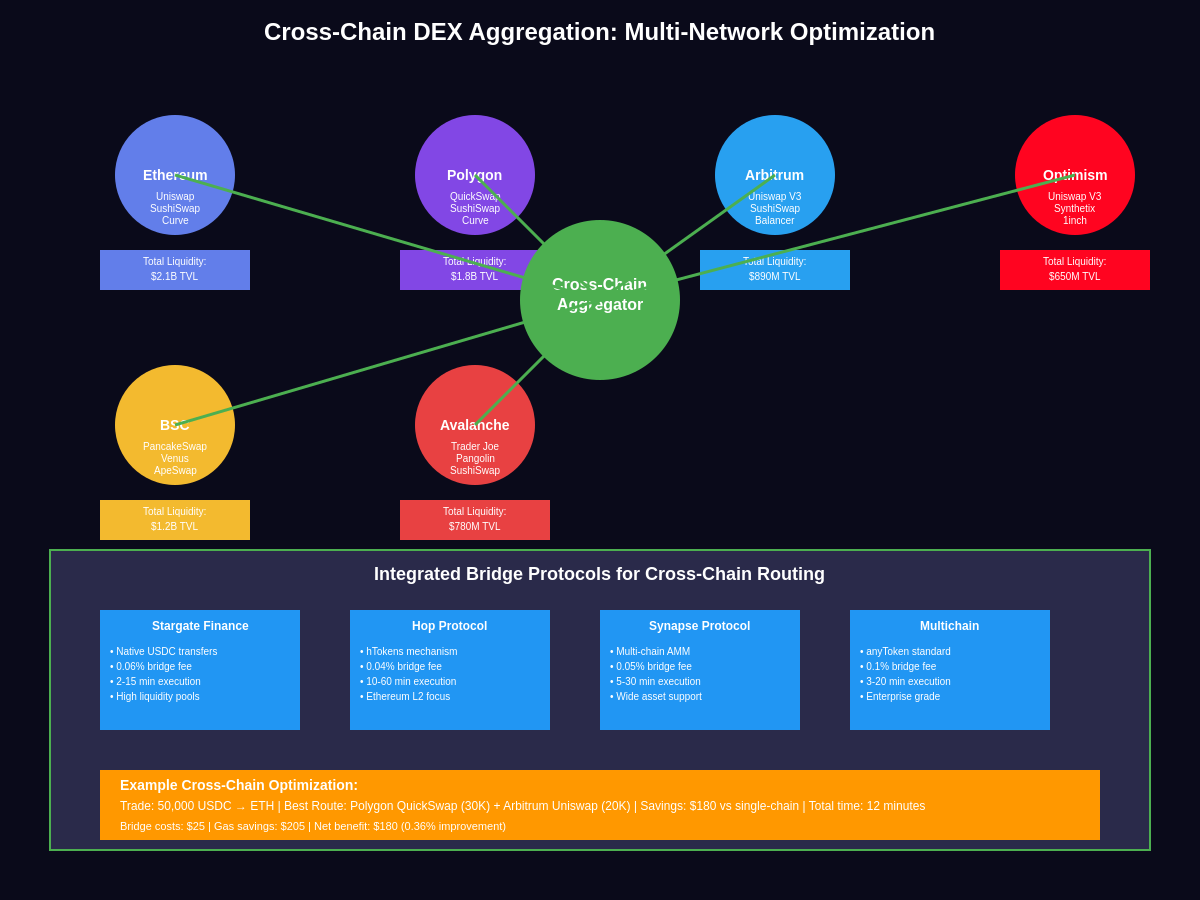
The expansion of DeFi across multiple blockchain networks has created new opportunities and challenges for DEX aggregators, as traders increasingly seek access to liquidity and trading opportunities across different ecosystems. Cross-chain aggregation represents the next frontier in DEX aggregator evolution, requiring sophisticated technical solutions to bridge liquidity across networks while maintaining the speed and efficiency that users expect.
Cross-chain routing algorithms must navigate the complexities of different blockchain architectures, consensus mechanisms, and smart contract capabilities while identifying arbitrage opportunities that exist across network boundaries. These algorithms consider not only the pricing differences between exchanges on different chains but also the costs and time requirements associated with cross-chain bridge transactions.
The technical implementation of cross-chain aggregation involves integration with various bridge protocols, including Stargate, Hop Protocol, and Synapse, each offering different trade-offs in terms of security, speed, and supported assets. Aggregators must evaluate these options dynamically based on current bridge conditions, liquidity availability, and user requirements to provide optimal cross-chain routing services.
Liquidity fragmentation across chains presents both challenges and opportunities for aggregators. While the division of liquidity across multiple networks can reduce the available depth for large trades on any single chain, it also creates arbitrage opportunities that sophisticated aggregators can exploit to provide better pricing than would be available through single-chain routing.
Professional traders tracking multi-chain DeFi protocols and cross-chain bridge activity benefit from aggregators that can seamlessly navigate cross-chain complexities while providing transparent information about the risks and costs associated with multi-network trading strategies.
Integration Strategies for Institutional and Professional Traders
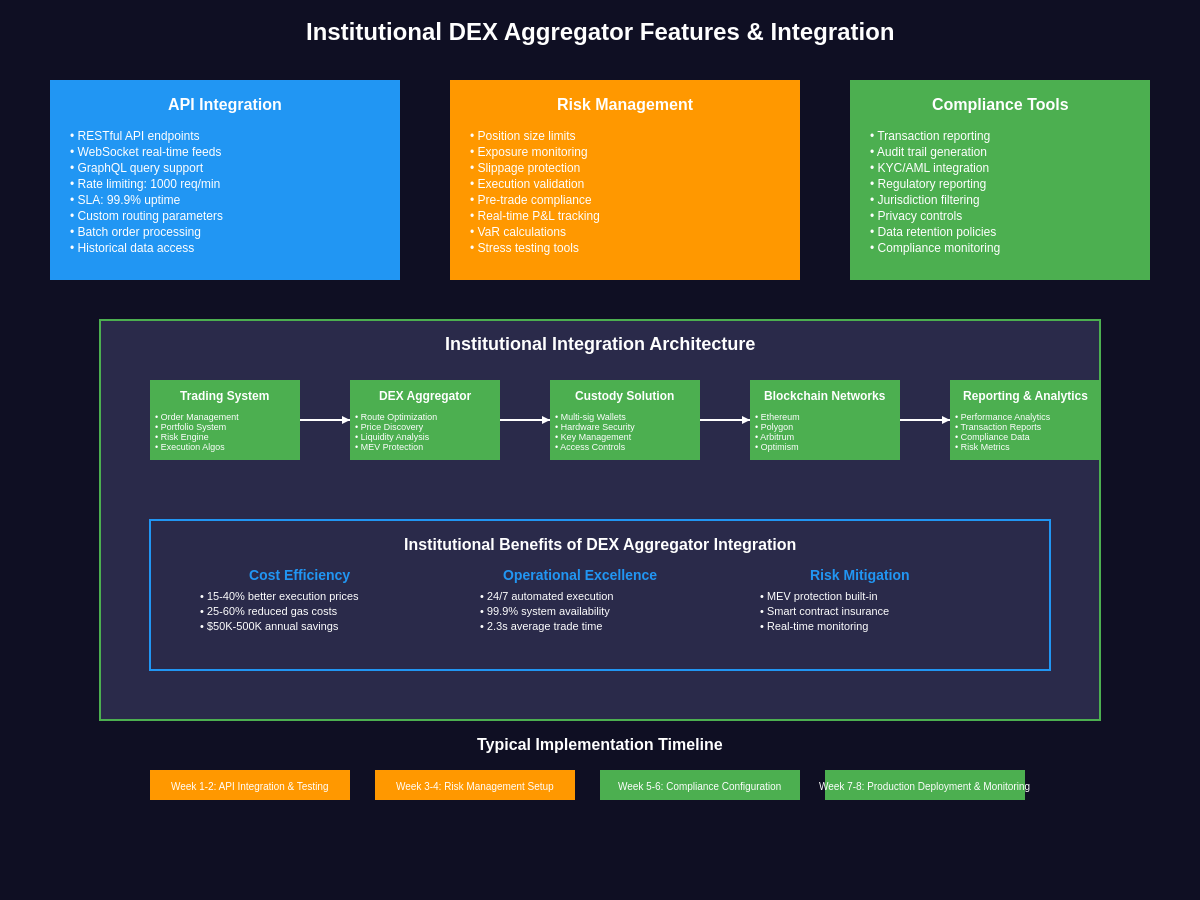
The institutional adoption of DEX aggregators requires sophisticated integration strategies that address the unique needs of professional trading organizations, including compliance requirements, risk management protocols, and integration with existing trading infrastructure. Leading aggregators have developed comprehensive APIs and integration tools designed to serve institutional clients while maintaining the decentralized principles that define the DeFi ecosystem.
API integration capabilities enable institutional traders to incorporate DEX aggregator functionality into their existing trading systems, risk management platforms, and portfolio management tools. These APIs provide programmatic access to routing algorithms, real-time pricing data, and execution capabilities while offering the customization options that institutional clients require for their specific trading strategies.
Risk management integration represents a critical component of institutional DEX aggregator adoption, as professional trading organizations must maintain strict controls over trade execution, position sizing, and exposure management. Advanced aggregators provide risk management hooks that allow institutions to implement custom validation logic, position limits, and execution approval workflows while maintaining the efficiency benefits of automated routing.
Compliance considerations have become increasingly important as institutional interest in DeFi grows, with aggregators implementing features such as transaction reporting, audit trails, and KYC/AML integration options. These features enable institutional clients to maintain regulatory compliance while accessing the liquidity and efficiency benefits of decentralized trading infrastructure.
The integration of DEX aggregators with institutional custody solutions addresses one of the primary concerns for professional traders seeking to participate in DeFi markets. Solutions that enable seamless interaction between institutional custody providers and DEX aggregators allow professional traders to maintain their security standards while accessing decentralized liquidity sources.
Future Developments and Technological Innovation
The future of DEX aggregation technology promises continued innovation in areas ranging from artificial intelligence integration to novel consensus mechanisms designed specifically for trading optimization. Machine learning algorithms are becoming increasingly sophisticated in their ability to predict optimal routing strategies, learn from market microstructure patterns, and adapt to changing network conditions in real-time.
Intent-based architectures represent a paradigm shift in how users interact with DEX aggregators, allowing traders to specify desired outcomes rather than specific execution paths. These systems use advanced algorithms to determine the optimal method for achieving user objectives, potentially incorporating complex multi-step strategies that involve lending, borrowing, and trading across multiple protocols to maximize value.
Zero-knowledge proof integration offers the potential for enhanced privacy in DEX aggregation, allowing users to benefit from sophisticated routing algorithms without revealing their trading intentions or strategies to other market participants. This technology could enable new forms of MEV protection while maintaining the transparency and verifiability that users expect from decentralized systems.
The development of application-specific blockchains optimized for trading and DEX aggregation represents another frontier for innovation. These specialized networks could provide enhanced performance, reduced costs, and novel features specifically designed to support advanced aggregation strategies while maintaining interoperability with existing DeFi infrastructure.
Advanced traders and institutions monitoring emerging DeFi technologies and protocol developments can position themselves to take advantage of these technological advances as they mature and become available in production environments.
Risk Management and Security Considerations
The security landscape surrounding DEX aggregators encompasses multiple layers of risk that users must understand and manage appropriately. Smart contract risk represents the most fundamental concern, as aggregators rely on complex smart contract systems that interface with numerous external protocols, each potentially introducing vulnerabilities or unexpected behaviors that could impact user funds.
The interconnected nature of DEX aggregator architecture means that security vulnerabilities in any connected protocol can potentially impact aggregator users, even if the aggregator’s own smart contracts are secure. This systemic risk requires users to consider not only the security of the aggregator platform they choose but also the security posture of all integrated exchanges and protocols.
Slippage protection mechanisms built into modern aggregators help users manage the risk of unfavorable price movements during trade execution, but these protections must be properly configured based on market conditions and trade characteristics. Understanding how slippage tolerance settings interact with routing algorithms and market volatility is essential for effective risk management.
The temporal nature of blockchain execution introduces execution risk that differs significantly from traditional trading environments. The time delay between transaction submission and confirmation can result in significant price movements, particularly during volatile market conditions or network congestion periods. Advanced aggregators provide tools for managing this execution risk through various means, including deadline parameters and dynamic slippage adjustment mechanisms.
Economic Impact and Market Efficiency Enhancement
DEX aggregators have fundamentally transformed the efficiency dynamics of decentralized trading markets by reducing friction in the price discovery process and enabling more efficient capital allocation across the DeFi ecosystem. The presence of sophisticated aggregation services has led to tighter spreads between exchanges, reduced arbitrage opportunities, and improved overall market efficiency as price discrepancies are quickly identified and eliminated.
The competitive pressure created by aggregators has driven innovation across individual DEX platforms, as exchanges must continuously improve their offerings to maintain competitiveness in aggregator routing algorithms. This competition has resulted in reduced fees, improved user interfaces, and enhanced technical capabilities across the entire DEX ecosystem.
Volume aggregation effects have enabled smaller DEX platforms to access order flow that would otherwise be concentrated on larger exchanges, promoting decentralization and reducing the market dominance of any single trading venue. This distribution of trading activity contributes to the overall resilience and decentralization of the DeFi ecosystem.
The data and analytics generated by DEX aggregators provide valuable insights into market microstructure, trading patterns, and liquidity dynamics that benefit the entire DeFi research community. This transparency enables better understanding of decentralized market behavior and supports the development of more sophisticated trading strategies and risk management approaches.
Conclusion and Future Outlook
DEX aggregators have established themselves as essential infrastructure components within the DeFi ecosystem, providing sophisticated solutions to the complex challenges of multi-exchange trading optimization. As the decentralized finance space continues to evolve and mature, these platforms will likely play an increasingly important role in ensuring efficient price discovery, optimal trade execution, and seamless user experiences across the fragmented landscape of decentralized exchanges.
The ongoing development of cross-chain capabilities, MEV protection mechanisms, and institutional-grade features positions DEX aggregators to serve as bridges between traditional finance and decentralized markets. As regulatory frameworks develop and institutional adoption accelerates, aggregators that successfully balance innovation with compliance requirements will likely capture significant market share and drive further adoption of decentralized trading infrastructure.
The technological foundations laid by current aggregator platforms provide a solid base for future innovations in areas such as artificial intelligence, intent-based trading, and novel consensus mechanisms. These developments promise to further enhance the efficiency and user experience of decentralized trading while maintaining the principles of transparency, decentralization, and user sovereignty that define the DeFi movement.
Professional traders and institutions seeking to participate in the evolving DeFi landscape will find DEX aggregators to be invaluable tools for accessing distributed liquidity sources while managing the complexities and risks associated with decentralized trading. The continued evolution of these platforms will likely play a crucial role in the broader adoption and maturation of decentralized finance as a viable alternative to traditional financial infrastructure.
For market participants utilizing advanced trading analytics and DeFi market intelligence, DEX aggregators represent both powerful tools for strategy implementation and important indicators of overall market health and efficiency within the rapidly evolving decentralized finance ecosystem.
Disclaimer: This article is for educational and informational purposes only and should not be construed as financial advice. Cryptocurrency trading and DeFi participation carry significant risks, including the potential for total loss of capital. DEX aggregators, while providing useful services, do not eliminate the risks associated with smart contract vulnerabilities, market volatility, or regulatory changes. Always conduct thorough research, understand the risks involved, and consult with qualified financial advisors before making investment decisions. The author and publisher are not responsible for any financial losses that may occur from acting on the information provided in this article.